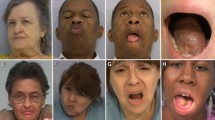Abstract
The present study was performed to investigate the reliability and validity of a new device for the assessment of oral dyskinesias by means of digital image processing. Twenty schizophrenic patients with tardive dyskinesia (TD) and ten healthy controls were studied. In patients instrumental scores were compared to different clinical rating scale scores. Measurements were repeated after 2 weeks under the same circumstances to assess test-retest stability. Instrumental scores discriminated well between normal subjects and dyskinetic patients and correlated significantly with clinical ratings (r=0.63). The test-retest correlations showed a correspondence not larger than 40%, detecting thus the fluctuation of the TD intensity over time. These results suggest that our device is a reliable and easy to handle technique for the assessment of TD. Furthermore, the ability of the device to analyze the frequency distribution of movements makes it a useful tool for the quantitative and qualitative analysis of TD.
Similar content being viewed by others
References
Bartzokis G, Wirshing WC, Hill MA, Cummings JL, Altshuler L, May PRA (1989) Comparison of electromechanical measures and observer ratings of tardive dyskinesia. Psychiatry Res 27:193–198
Caligiuri MP, Harris MJ, Jeste DV (1988) Quantitative analysis of voluntary orofacial motor control in schizophrenia and tardive dyskinesia. Biol Psychiatry 24:787–800
Denney D, Casey DE (1975) An objective method for measuring dyskinetic movements in tardive dyskinesia. Electroencephalogr Clin Neurophysiol 38:645–646
Gattaz WF, Büchel C (1993) Tardive dyskinesia: recognition and quantification by means of digital image processing. Psychopharmacology 111:278–284
Jus K, Jus A, Villeneuve A (1973) Polygraphic profile of oral tardive dyskinesia and of rabbit syndrome: For quantitative and qualitative evaluation. Dis Nerv Syst 34:27–32
National Institute of Mental Health Psychopharmacology Research Branch (1975) Development of a dyskinetic movement scale. ECDEU Intercom 4:3–6
Resek G, Haines J, Sainsbury P (1981) An ultrasound technique for the measurement of tardive dyskinesia. Br J Psychiatry 138:474–478
Richardson MA, Craig TJ, Branchey MH (1982) Intra-patient variability in the measurement of tardive dyskinesia. Psychopharmacology 76:269–272
Schooler NR, Kane JM (1982) Research diagnoses for tardive dyskinesia. Arch Gen Psychiatry 34:21–35
Simpson GM, Lee JH, Zoubok B, Gardos G (1979) A rating scale for tardive dyskinesia. Psychopharmacology 64:171–179
Wirshing WC, Cummings JL, Dencker SJ, May PRA (1991) Electromechanical characteristics of tardive dyskinesia. Neuropsychiatry Clin Neurosci 3:10–17
Author information
Authors and Affiliations
Rights and permissions
About this article
Cite this article
Büchel, C., Gattaz, W.F., de Leon, J. et al. Oral tardive dyskinesia: validation of a measuring device using digital image processing. Psychopharmacology 117, 162–165 (1995). https://doi.org/10.1007/BF02245182
Received:
Revised:
Issue Date:
DOI: https://doi.org/10.1007/BF02245182




